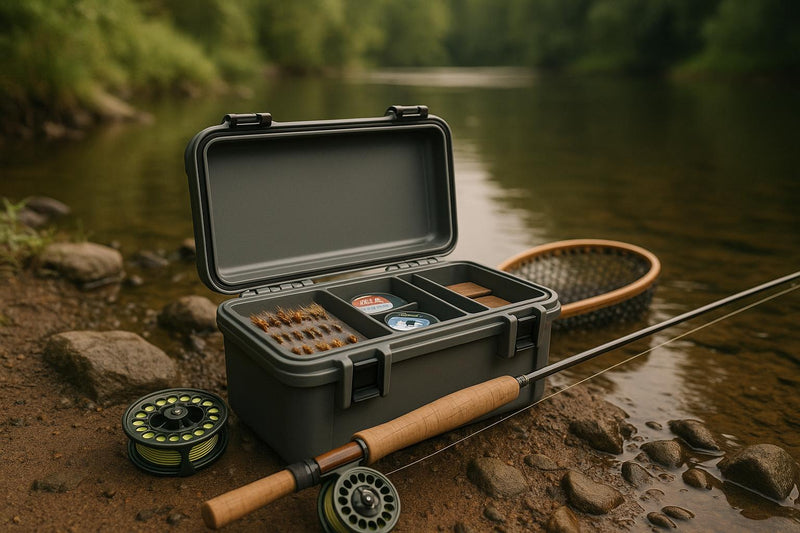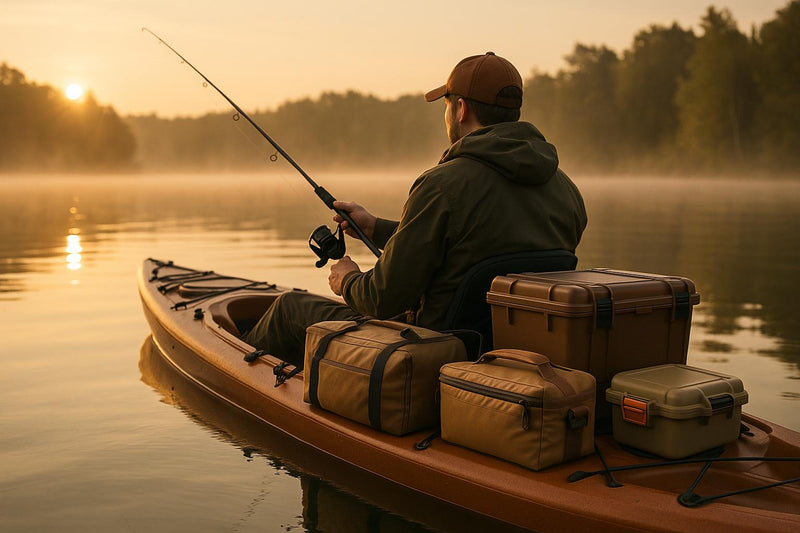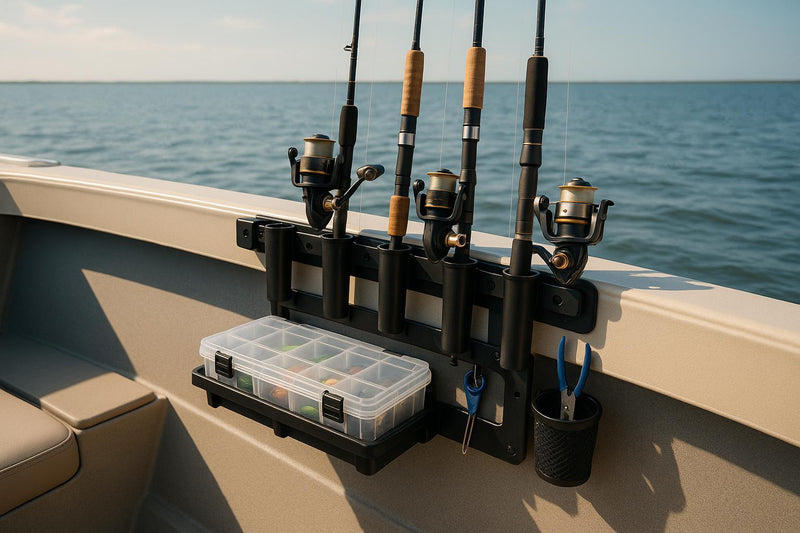Fishing shorts made from upcycled fabrics are reshaping the way anglers think about gear. These materials, crafted from discarded fishing nets and plastic bottles, combine high performance with a reduced environmental footprint. Here's why they matter:
- What are upcycled fabrics? They repurpose waste into durable textiles without breaking materials down entirely, unlike recycling.
- Why use them in fishing gear? They offer durability, water resistance, and quick-dry properties while addressing waste issues like ocean pollution.
- How are they sourced? Materials like ghost nets and PET bottles are collected, cleaned, and transformed into nylon and polyester fibers for production.
- Environmental benefits: Lower carbon emissions, reduced water usage, and cleaner oceans.
- Challenges: Microplastic shedding and non-biodegradability remain concerns, but proper care and recycling can mitigate these.
Upcycled fishing shorts deliver advanced performance features - moisture-wicking, four-way stretch, and quick-dry technology - while supporting cleaner oceans. As demand grows, innovations in fabric production promise even better options for anglers. Whether you're casting a line or wading through water, these shorts prove you can have functionality and eco-consciousness in one package.
Types of Upcycled Fabrics Used in Fishing Shorts
Fishing shorts made from upcycled fabrics primarily rely on recycled nylon and polyester - materials repurposed from waste into tough, high-performance textiles. Let’s take a closer look at how these materials are transformed into gear designed for anglers.
Recycled Nylon from Discarded Fishing Nets
Old fishing nets and other nylon waste are collected through various environmental initiatives. These materials are then processed into strong, water-resistant nylon fibers, making them perfect for crafting Men’s Fishing Shorts that can handle the challenges of marine environments.
Recycled Polyester from Plastic Bottles
Used plastic bottles are gathered, sorted, cleaned, and shredded into small pieces. These are melted down and reshaped into polyester fibers. The result? A lightweight, quick-drying fabric that’s ideal for fishing shorts.
Both recycled nylon and polyester are seamlessly integrated into modern fishing shorts, enabling features like water-resistant treatments and quick-dry technology. These fabrics prove that eco-friendly choices and top-tier performance can go hand in hand, delivering fishing gear that’s both functional and environmentally conscious.
Sourcing and Production of Upcycled Fabrics
The transformation of ocean waste into high-performance Fishing Shorts is a fascinating process that combines efficient collection systems with advanced manufacturing techniques. This journey highlights the intricate steps involved in creating fishing apparel that prioritizes both functionality and sustainability.
Collection Processes for Waste Materials
The foundation of upcycled fabrics lies in organized ocean cleanup efforts and coastal collection programs. Abandoned fishing nets, often called ghost nets, are retrieved through collaborations between environmental groups and local fishing communities. Meanwhile, plastic bottles are collected through recycling networks across the United States. These networks sort bottles by type, with PET (polyethylene terephthalate) bottles being the primary material for recycled polyester. During sorting, caps, labels, and other contaminants are removed to ensure only clean, high-quality plastic enters the recycling stream. Strict quality control at this stage ensures the integrity of materials used in the upcycling process.
Transforming Waste into Usable Fabric
Turning waste into durable fabrics for Mens Fishing Shorts involves several carefully managed steps. For fishing nets, the process starts with shredding them into chips, followed by thorough cleaning to remove salt, marine debris, and other residues. These nylon chips are then melted down and extruded through spinnerets to create continuous filaments. These filaments are further processed to achieve the strength and flexibility required for fishing gear.
Similarly, plastic bottles are cleaned and shredded into flakes after the removal of labels and adhesives. These flakes are washed to eliminate any remaining contaminants, then melted and transformed into polyester fibers. The fibers are spun into yarn, which is then woven or knitted into fabrics that meet the performance standards demanded by anglers.
Responsible Sourcing Practices
Ensuring ethical and sustainable sourcing of upcycled materials requires a commitment to transparency and accountability. The Global Recycled Standard (GRS) plays a key role in verifying that recycled materials adhere to environmental and social criteria throughout the production process.
Chain-of-custody documentation tracks materials from their collection points to the final fabric, ensuring the recycled content is accurately represented. Direct partnerships between fabric manufacturers and collection organizations help maintain consistent material quality, while third-party audits confirm that energy use, water consumption, and chemical treatments align with sustainability goals. These practices not only preserve the quality of the materials but also minimize the overall environmental impact, as explored further in the next section.
Environmental Impact of Upcycled Fabrics
Using upcycled materials in Fishing shorts provides a range of environmental benefits while addressing some of the fishing industry's pressing ecological challenges. These advantages align closely with the improved functionality of fishing apparel we've previously discussed.
Reduced Carbon Footprint
Producing upcycled fabrics typically requires less energy than creating new materials from scratch. For instance, turning plastic bottles into polyester fibers for Mens Fishing Shorts consumes less energy and generates fewer CO2 emissions compared to manufacturing polyester from petroleum. Similarly, recycled nylon, often made from discarded fishing nets, not only cuts down greenhouse gas emissions but also helps clear harmful waste from oceans. Additionally, producing recycled polyester uses less water than virgin polyester - an important factor given the increasing concerns around water scarcity.
Challenges with Upcycled Fabrics
While upcycled fabrics offer clear environmental advantages, they’re not without their challenges. One issue is the shedding of microplastics during washing, a problem shared by synthetic fabrics in general. These materials are also non-biodegradable, making their proper recycling or disposal essential to avoid contributing to landfill waste.
Another concern lies in the chemical treatments often used to enhance fabric performance, such as water resistance and quick-dry properties. These processes require careful oversight to minimize environmental impact. Additionally, the condition of source materials like discarded fishing nets can vary, sometimes requiring extra processing to ensure consistent quality.
Comparison: Upcycled Nylon vs. Virgin Nylon
Here’s a closer look at how upcycled nylon stacks up against virgin nylon in terms of environmental impact:
| Factor | Upcycled Nylon | Virgin Nylon |
|---|---|---|
| Raw Material Source | Discarded fishing nets and carpet waste | Derived from petroleum |
| CO2 Emissions | Lower emissions during production | Higher emissions from petroleum processing |
| Water Usage | Reduced water consumption | Standard water usage |
| Biodegradability | Non-biodegradable | Non-biodegradable |
| Microplastic Release | Similar shedding rates during washing | Similar shedding rates during washing |
| Cost | Generally higher due to extra processing | Typically lower production costs |
| Ocean Impact | Helps remove waste from marine environments | No direct benefit to ocean cleanup |
This comparison underscores the benefits of upcycled nylon, particularly in reducing emissions and cleaning up marine waste. However, it also highlights shared challenges, such as microplastic release and non-biodegradability, which emphasize the importance of proper care and recycling for all synthetic materials.
Opting for fishing shorts made from upcycled materials is a step toward cleaner oceans and reduced dependence on fossil fuels. While the industry continues working to improve the sustainability of synthetic fabrics, these choices already make a difference.
sbb-itb-cb0a783
Performance and Comfort Benefits for Anglers
Upcycled materials don’t just benefit the planet - they also deliver the same performance and comfort as traditional fabrics. For anglers, this means you can enjoy long days on the water without sacrificing functionality or ease of movement.
Performance Features of Upcycled Fabrics
According to Blue Associates Sportswear:
"Recycled polyester maintains the same performance qualities as virgin polyester, including moisture-wicking, breathability, and durability."
This means your fishing shorts made from recycled plastic bottles will keep you dry and comfortable, even in challenging conditions. Their moisture-wicking properties are a game-changer for humid, spray-filled environments, while four-way stretch fabric ensures you can cast, reel, and move around the boat without restriction.
Quick-dry technology is another key feature of upcycled fabrics. Whether you’re splashed by waves or caught in an unexpected rain shower, these shorts dry quickly, so you won’t be stuck with that cold, damp feeling all day. These performance benefits not only keep you focused on the task at hand but also contribute to overall comfort.
Comfort and Ergonomic Design
Beyond technical performance, ergonomic design adds another layer of comfort for anglers. Features like removable thigh pads provide critical support when bracing your leg against a fishing rod during a long battle with a big catch. Meanwhile, water-resistant properties help you stay comfortable, even in persistently wet conditions.
Blue Associates Sportswear also highlights the versatility of recycled nylon:
"Recycled nylon retains the durability and elasticity of virgin nylon, making it suitable for sportswear."
This elasticity is especially useful when you need to move quickly - whether to grab your gear or secure a fish. Paired with anti-chafe seams and reinforced stitching, upcycled fabrics hold up under pressure, ensuring your shorts move with you rather than working against you.
Benefits for Anglers
Fishing shorts made from upcycled materials offer a range of practical advantages. Moisture management reduces fatigue, breathable fabrics help regulate temperature, and durable construction stands up to saltwater, UV rays, and the wear and tear of frequent use.
Upcycled fabrics also provide better long-term value. They resist the harsh effects of saltwater and sunlight, making them a reliable choice for anglers season after season. Additionally, functional storage features - like secure, well-structured pockets - maintain their shape over time, ensuring your essentials stay safe and accessible throughout your fishing trips.
When performance and comfort come together in sustainable designs, they create fishing apparel that doesn’t just work well but also supports eco-friendly practices. That’s a win for anglers and the environment alike.
The Future of Upcycled Fabrics in Fishing Apparel
The fishing apparel industry is leading the charge when it comes to sustainable advancements. With growing environmental awareness and technological progress, upcycled fabrics are becoming a game-changer for high-performance fishing gear. These materials not only address performance needs but also tackle environmental concerns, setting the stage for a more sustainable future in fishing apparel.
Key Highlights
Upcycled fabrics are designed to meet the rigorous demands of anglers. For instance, recycled polyester is known for its quick-drying properties, while recycled nylon offers the durability and flexibility essential for products like Mens Fishing Shorts.
The environmental upside is just as important. Incorporating upcycled materials helps lower the carbon footprint of the fishing industry and reduces ocean waste, promoting healthier marine ecosystems.
Smart textiles are poised to take upcycled fabrics to the next level. Future innovations might include AI-driven design tools and cutting-edge manufacturing processes. Smart textile technologies - such as light sensors and conductive yarns - could enhance the functionality of fishing apparel. Imagine clothing that adjusts ventilation or monitors body temperature, all integrated into upcycled fabrics. Products like advanced Fishing shorts hint at this exciting potential. As technology evolves, consumer preferences will play a key role in shaping these advancements.
The Power of Consumer Demand
Anglers themselves are driving this shift toward sustainability. As more fishermen understand the importance of protecting marine environments, the demand for eco-friendly gear continues to grow. Manufacturers are answering the call by investing in better recycling technologies and innovative upcycled fabric solutions.
Techniques like waterless dyeing, plasma treatment, and digital printing are making it easier to transform waste into high-performance fabrics while minimizing environmental harm. These methods build on the already proven advantages of upcycled materials. Over time, these advancements are expected to make upcycled fabrics even more efficient and cost-effective.
Now is the perfect time to embrace eco-friendly fishing gear. Today’s upcycled fabrics already meet the performance standards anglers expect, and upcoming technologies promise even more impressive features. Whether you’re after water resistance, enhanced comfort, or both, upcycled materials deliver on all fronts. Explore the possibilities with forward-thinking products like Mens Fishing Shorts from Reel Comfort, and be part of the movement toward a more sustainable future.
FAQs
How do fishing shorts made from upcycled materials compare to those made from traditional materials?
Fishing shorts made from upcycled materials often hold their own - and sometimes even outperform - traditional options when it comes to durability and functionality. Recycled fibers are engineered to be tough and long-lasting, standing up well to the wear and tear of extended fishing trips.
On top of their solid performance, these shorts offer a major environmental perk. By using upcycled materials, they help cut down on waste and conserve natural resources. While some recycled fabrics might have minor drawbacks, ongoing advancements in recycling technology are steadily enhancing their quality. This makes eco-conscious fishing shorts a dependable and resource-friendly option for anglers.
How are fishing shorts made from upcycled fabrics addressing the issue of microplastic shedding?
Manufacturers are addressing the issue of microplastic shedding in fishing shorts made from upcycled fabrics by exploring creative solutions. For instance, they’re improving textile production techniques, like fine-tuning chemical and mechanical finishing processes, to cut down on microfiber release. On top of that, new laundry technologies are being designed to trap microfibers during washing, helping to limit their environmental footprint.
By prioritizing these sustainable approaches, fishing shorts made from upcycled fabrics not only give new life to discarded materials but also play a role in reducing microplastic pollution - making them a smarter, greener option for anglers.
What is the best way to care for upcycled fishing shorts to maintain their durability and performance?
To keep your upcycled fishing shorts looking and performing their best, stick to a few simple care tips. Wash them in cold water using a mild, eco-friendly detergent to protect the fabric. Skip the fabric softeners and bleach - these can weaken the material over time. For drying, air drying is the way to go. It helps prevent shrinkage and keeps the material in great shape, while tumble drying should be avoided. Always check the care label for any specific instructions. Taking these steps will help maintain the durability, color, and water-resistant properties of your shorts, so they're ready for every fishing adventure.




